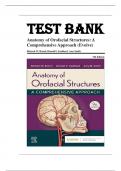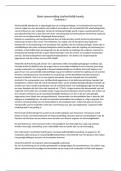,Chapter 01: Oral Cavity Brand/Isselhard: Anatomy of Orofacial Structures, 9th Edition
r r r r r r r r r r
MULTIPLE CHOICE r
1. A diastema is a space between two teeth in the same arch. When this occurs between the
r r r r r r r r r r r r r r r r
maxillary central incisors, it is often the result of a pronounced labial frenum. a. Both
r r r r r r r r r r r r r r r
r statements are true. r r
b. Thefirst statement is true; the second statement is false.
r r r r r r r r r
c. Thefirst statement is false; the second statement is true.
r r r r r r r r r
d. Both statements are false. r r r
ANS: A r
A space, or lack of contact area, between anytwo teeth in the same arch is called a diastema. When
r r r r r r r r r r r r r r r r r r r
a diastema occurs between the maxillary central incisors, it is often the result of a pronounced
r r r r r r r r r r r r r r r r
labial frenum extending to the crest of the alveolar ridge and possibly over the ridge. This band
r r r r r r r r r r r r r r r r r
of firm connective tissue causes the erupting incisors to be pushed aside resulting in a diastema,
r r r r r r r r r r r r r r r r
or space. Correction of a diastema usuallyinvolves surgical removal, or cutting, of the frenal
r r r r r r r r r r r r r r r
tissue between teeth.
r r r
REF: p. 3 r r
OBJ: To describe the boundaries and sub-boundaries of the oral cavity and the structures in each area
r r r r r r r r r r r r r r r r
NAT: CDA: GC I.A.6. Identify basic oralanatomy and physiology, includingbut not limited to: oral
r r r r r r r r r r r r r r r
cavity. TOP:
r BLOOM: Remembering r r
2. Torus palatinus is seen on the r r r r r
a. soft palate r
b. hard palate r
c. alveolar ridge r
d. oral pharynx r
ANS: B r
Torus palatinus is excess bone growth and occurs in the midline of the hard palate. It may grow
r r r r r r r r r r r r r r r r r
to varying sizes and is generallyonlya problem when the construction of a maxillary denture is
r r r r r r r r r r r r r r r r r
necessary. In health, such bony protuberances, or excess bone growths, do not occur on the
r r r r r r r r r r r r r r r
soft palate, alveolar ridge, or oral pharynx.
r r r r r r r
REF: p. 5 r r
OBJ: To define the terms vestibule, oral cavityproper,mucobuccal fold, frenum, alveolar mucosa,
r r r r r r r r r r r r r
gingiva, exostoses, torus palatinus, and torus mandibularis
r r r r r r r
NAT: CDA: GC I.A.2. Identify basic oralanatomy and physiology, includingbut not limited to: bones. TOP:
r r r r r r r r r r r r r r r r
BLOOM: Remembering
r r
3. Contraction of which muscle raises the tongue upward? r r r r r r r
a. Mylohyoid
, b. Palatopharyngeal
c. Palatoglossal
d. Levator glossal r
ANS: A r
Contraction of the mylohyoid muscle raises the tongue. The palatopharyngeal muscle and the
r r r r r r r r r r r r
palatoglossal muscle form the posterolateral borders of the oral cavity. There is not a muscle by the
r r r r r r r r r r r r r r r r r
name of levator glossal.
r r r r
REF: p. 7 r r
OBJ: To define the landmarks in thefloor of the mouthand the hard and soft palate and the structures that form
r r r r r r r r r r r r r r r r r r r r r
them
r
NAT: CDA: GC I.A.4. Identify basic oralanatomy and physiology, includingbut not limited to:
r r r r r r r r r r r r r r
muscles.
r TOP: BLOOM: Remembering r r
4. Theoral vestibule is partiallybordered bythelips and cheeks. Theoral cavityproper
r r r r r r r r r r r r r r
extends posteriorly to the soft palate. a. Both statements are true.
r r r r r r r r r r r
b. Thefirst statement is true; the second statement is false.
r r r r r r r r r
c. Thefirst statement is false; the second statement is true.
r r r r r r r r r
d. Both statements are false. r r r
ANS: B r
The oral vestibule is the space or potential space that exists between the lips or cheeks and teeth.
r r r r r r r r r r r r r r r r r
In an edentulous person, the vestibule would extend between the lips or cheeks and the alveolar
r r r r r r r r r r r r r r r r
ridges. The oral cavity proper is surrounded by teeth or alveolar ridges and extends all the way back
r r r r r r r r r r r r r r r r r r
to the palatine tonsils. This includes the region from the floor of the mouth upward to the hard
r r r r r r r r r r r r r r r r r r
and soft palates.
r r r
REF: p. 2 r r
OBJ: To describe the boundaries and sub-boundaries of the oral cavity and the structures in each area
r r r r r r r r r r r r r r r r
NAT: CDA: GC I.A.6. Identify bUas icSoIr
r r r r
N R r
alNa naTt o m.yCanOd
G r
r
B r
Mphysiology, including but not limitedto: oral cavity. TOP: BLOOM: Remembering
r r r r r r r r r r
5. Each of the following is trueof the uvula EXCEPT one. Which one is the EXCEPTION?
r r r r r r r r r r r r r r r
a. It is located at the most posterior portion of the hard palate.
r r r r r r r r r r r
b. It is located at the midline.
r r r r r
c. It is a downwardlyprojecting muscle.
r r r r r
d. It is necessary for swallowing.
r r r r
ANS: D r
Theuvulais adownwardlyprojectingmusculartissue locatedat themidline ofthe most
r r r r r r r r r r r r r r
posterior portion of the hard palate. It is NOT necessary for swallowing.
r r r r r r r r r r r r
, REF: p. 6 r r
OBJ: To define the landmarks in thefloor of the mouthand the hard and soft palate and the structures that form
r r r r r r r r r r r r r r r r r r r r r
them
r
NAT: CDA: GC I.A.6. Identify basic oralanatomy and physiology, includingbut not limited to: oral
r r r r r r r r r r r r r r r
cavity. TOP: BLOOM: Remembering
r r r r
6. The circumvallate papillae are located on the hard palate, buccal mucosa, and floor of the
r r r r r r r r r r r r r r
mouth. The papillae found on the tongue are the filiform, fungiform, vallate, foliate, and
r r r r r r r r r r r r r r
incisive.
r
a. Both statements are true. r r r
b. Thefirst statement is true; the second statement is false.
r r r r r r r r r
c. Thefirst statement is false; the second statement is true.
r r r r r r r r r
d. Both statements are false. r r r
ANS: D r
All papillae listed in both statements are located on the tongue with the exception of the incisive
r r r r r r r r r r r r r r r r
papilla, which is located on the hard palate. Note that the incisive papilla is a singular structure, thus
r r r r r r r r r r r r r r r r r r
the different spelling. There are no papillae located on either the buccal mucosa or the floor of the
r r r r r r r r r r r r r r r r r r
mouth.
r
REF: p. 7 r r
OBJ: To define the landmarks in thefloor of the mouthand the hard and soft palate and the structures that form
r r r r r r r r r r r r r r r r r r r r r
them
r
NAT: CDA: GC I.A.6. Identify basic oralanatomy and physiology, includingbut not limited to: oral
r r r r r r r r r r r r r r r
cavity. TOP: BLOOM: Remembering
r r r r
7. Each of the following structures can readilybe viewed when examining the oral cavity
r r r r r r r r r r r r r
EXCEPT one. Which one is the EXCEPTION? a. Fovea palatinae
r r r r r r r r r r
b. Tonsillarpillars r
c. Laryngeal pharynx r
d. Sublingual fold r
ANS: C r
The laryngeal pharynx is located below the oral pharynx and cannot be seen while examining the
r r r r r r r r r r r r r r r
oral cavity. The fovea palatinae, the tonsillar pillars, and the sublingual fold can be seen when
r r r r r r r r r r r r r r r r
examining the oral cavity. Fovea palatinae are small depressions in mucosa on either side of the
r r r r r r r r r r r r r r r r
posterior nasal spine indicating the junction of the hard and soft palate. Tonsillar pillars are folds
r r r r r r r r r r r r r r r r
of tissue that partially surround the tonsils. The sublingual fold extends
r r r r r r r r r r r
r bsubmandibularackward on eith gland.er side of thNe Uflo orSIof t r r r r r r r
R r
r NhG eTmB r
o.utCh OanMd is situated just superior to the r r r r r r r r
REF: p. 2 |pp. 6-7 r r rr r
OBJ: To describe the boundaries and sub-boundaries of the oral cavity and the structures in each area
r r r r r r r r r r r r r r r r





